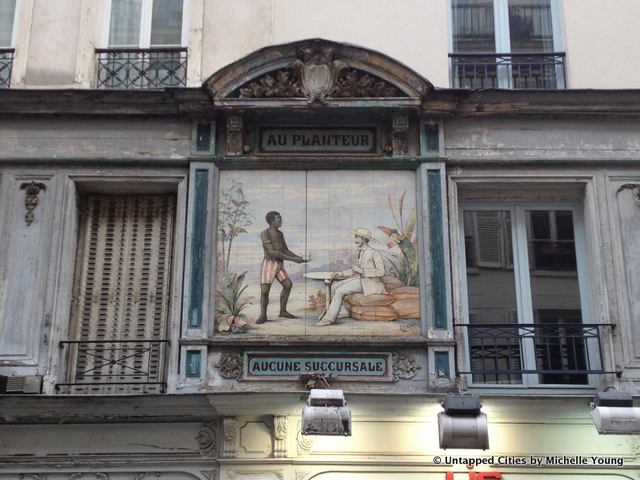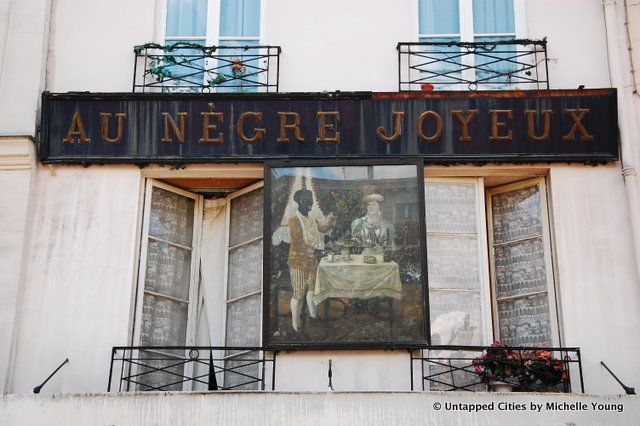
When we first posted the painting of the “Happy Negro (Au Nègre Joyeux)” above #12 Rue Mouffetard in the Latin Quarter, we were (admittedly) less well-versed in French history than we are now, and there were some wonderful comments on the article from readers situating the historical artifact properly. There was also a fun comment that the very building was mentioned in The Sun Also Rises by Ernest Hemingway: “Music came out of the Negre Joyeux. Through the window of the Café Aux Amateurs I saw the long zinc bar.” The same café is mentioned in A Moveable Feast as well.
In the 2nd arrondissement on Rue Montorgueil, a popular street in Paris, is another relic of France’s colonial past, labeled “Au Planteur Aucune Succursale,” showing a similar subject. It is important to note that words like negre were not originally pejorative in France and scenes like those depicted here, while shocking to tourists today, were simply signs of a new world that colonialism brought to France. The ceramic “Au Planteur” was an advertisement for a shop that sold products from the colonies, and the “aucune succursale,” refers to the fact that it was the only shop in Paris to carry such products. This type of signage is not very prevalent in Paris.
What interests us particularly, as urbanists, is the extent that preservation is upheld in Paris. In the United States, these types of remnants, if we had them, would almost definitely be removed—political correctness outweighing historic preservation. But is it better to erase the past, or to confront it in daily life, as in Paris? Perhaps a little plaque, educating tourists and residents alike would not be unwelcome in the few places these paintings still exist in Paris.

A quick summary of reader comments regarding Au Nègre Joyeux:
Untapped Reader Antoine writes, the “street sign has another story; it’s an old sign and should be seen as such. The word “Nègre” meant black in the old days, without the pejorative connotation is has today (In contemporary French, it is impossible to publicly use that word without breaking the law…) But it was a marketing tool in the past centuries.”
Brian Holstein commented, “The name [Negre Joyeux] was given because it was in this building a Madame Barry [sic], a ‘favourite’ of Louis XV, lived and sought out the companionship of the servant. He is smiling not because he has to as he says “Yes, massa”, but because he is genuinely happy. If you look again you will find that she too is smiling. The scene itself is a parody: the man is ‘serving’ the woman – it was a private joke amongst the locals after the discovery of the affair. The affair lasted quite some time until it was discovered: Madame Barry [sic] was chastised but secretly admired by the members of the court; the negre joyeaux was arrested and guillotined.”
Nito writes, “Since it’s protected as an historical monument, let’s give them a plaque, no problem.”
Read more about the remnants of France’s colonial past at the Jardin d’Agronomie Tropicale and the Palais de la Porte Dorée. Get in touch with the author @untappedmich.
Colonial Remnants in Paris: Au Planteur on Rue Montorgueil and Au Negre Joyeux
Michelle is the founder of Untapped New York. She is the author of Secret Brooklyn: An Unusual Guide, New York: Hidden Bars & Restaurants, and Broadway. She is a graduate of Harvard College in the History of Art and Architecture and holds a master’s degree in urban planning from Columbia University Graduate School of Architecture, Planning and Preservation, where she is an Adjunct Professor of Architecture. Official Website





